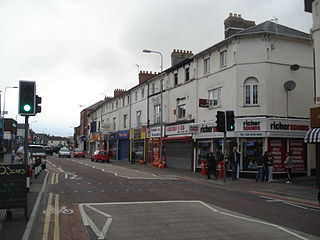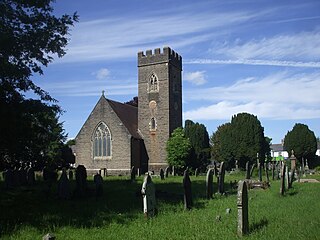
Llandaff Cathedral is an Anglican cathedral and parish church in Llandaff, Cardiff, Wales. It is the seat of the Bishop of Llandaff, head of the Church in Wales Diocese of Llandaff. It is dedicated to Saint Peter and Saint Paul, and three Welsh saints: Dubricius, Teilo and Oudoceus. It is one of two cathedrals in Cardiff, the other being the Roman Catholic Cardiff Metropolitan Cathedral in the city centre.

Newport Cathedral, also known as St Gwynllyw's or St Woolos' Cathedral, is the cathedral of the Diocese of Monmouth within the Church in Wales, and the seat of the Bishop of Monmouth. Its official title is Newport Cathedral of St Woolos, King and Confessor. The name of the saint, Woolos, is an anglicisation of the Welsh name Gwynllyw.

Llanedeyrn is a former village, now a district and community, in the east of the city of Cardiff, Wales, located around 3.5 miles from the city centre. The parish of Llanedeyrn rests on the banks of the river Rhymney and is visible nesting on a hill side above the A48(M), westbound on the approach into Cardiff.

The Diocese of Monmouth is a diocese of the Church in Wales. Despite the name, its cathedral is located not in Monmouth but in Newport — the Cathedral Church of St Woolos. Reasons for not choosing the title of Newport included the existence of a Catholic Bishop of Newport until 1916. This apparent anomaly arose in 1921 when the diocese was created with no location for the cathedral yet chosen. Various options were being considered, such as restoring Tintern Abbey, building from scratch on Ridgeway Hill in Newport, and upgrading St Woolos, then a parish church; in the meantime the new diocese, as it covers more or less the territory of the county of Monmouth, was named the "Diocese of Monmouth". Prior to 1921 the area had been the archdeaconry of Monmouth.

Canton is an inner-city district and community in the west of Cardiff, capital of Wales, lying 2 miles (3.2 km) west of the city's civic centre. It is located adjacent to Pontcanna. Canton is one of the most ethnically diverse of Cardiff's suburbs, with a significant Pakistani and Indian population. The total population of Canton increased to 14,304 at the 2011 census. It is also the most Welsh-speaking district of central Cardiff, with 19.1% of the population speaking Welsh.

The Diocese of Llandaff is an Anglican diocese that traces its roots to pre-Reformation times as heir of a Catholic bishopric. It is headed by the Bishop of Llandaff, whose seat is located at the Cathedral Church of Saint Peter and Saint Paul in Llandaff, a suburb of Cardiff. It currently covers most of the former Welsh county of Glamorgan, but once stretched from the River Towy to the middle of the Wye Valley.

St Teilo's Church in Wales High School is a co-educational secondary school now located in Llanedeyrn, Cardiff.

Pontprennau is a ward and community in the north of the city of Cardiff, Wales, lying north of Pentwyn and Cyncoed, between the village of Old St Mellons and the farmlands east of Lisvane. The community had a population of 7,353 in 2011.

Chitterne is a village and civil parish in the county of Wiltshire, in the south west of England. The village lies in the middle of Salisbury Plain, about 7 miles (11 km) east of the town of Warminster.

St John the Baptist Church is a Grade I listed parish church in Cardiff, Wales. Other than Cardiff Castle, it is the only medieval building in the city centre.
The Cardiff Deanery is a Roman Catholic deanery in the Archdiocese of Cardiff that oversees several churches in the city of Cardiff. It replaced the previous Cardiff East Deanery and Cardiff West Deanery, combining the two into one. The dean is centred at the Parish of St Mary's Canton.

The Cathedral of Saint Mary and Saint Anne, also known as Saint Mary's Cathedral, The North Cathedral or The North Chapel, is a Roman Catholic cathedral located at the top of Shandon Street in Cork, Ireland. It is the seat of the Bishop of Cork and Ross, and the mother church of the Roman Catholic Diocese of Cork and Ross. Its name derived from the fact that it encompassed the ecclesiastical parish of St. Mary and the civil parish of St. Anne.

Saint Isan was a 6th-century saint of South Wales and Patron Saint of Llanishen in Cardiff, Wales.

St John the Baptist Church is the Church of England parish church of Chipping Barnet, Greater London. It forms part of the Chipping Barnet Team Ministry, comprising St Mark's, Barnet Vale, St Peter's, Arkley and St Stephen's, Bell's Hill. It crowns the ascent up Barnet Hill, and stands at the junction of Wood Street and High Street. It is one of the few Anglican churches in Greater London to belong to the Diocese of St Albans.

St Isan's Church is a listed Anglican church in the suburb of Llanishen, Cardiff. The church's origins are medieval, though the present building was extensively remodeled during the Victorian and Edwardian years.

St Mary's Church, Whitchurch, is an Anglican place of worship in the suburb of Whitchurch, Cardiff. The Victorian building is listed.

St Mary's Church is the Church of England parish church in the town of Marlborough, Wiltshire, England.

The Church of All Saints is the main Church of England parish church in Westbury, Wiltshire, England. There has been a church on the site since Saxon times, and the current church, largely rebuilt around 1437, is a Grade I listed building.


















